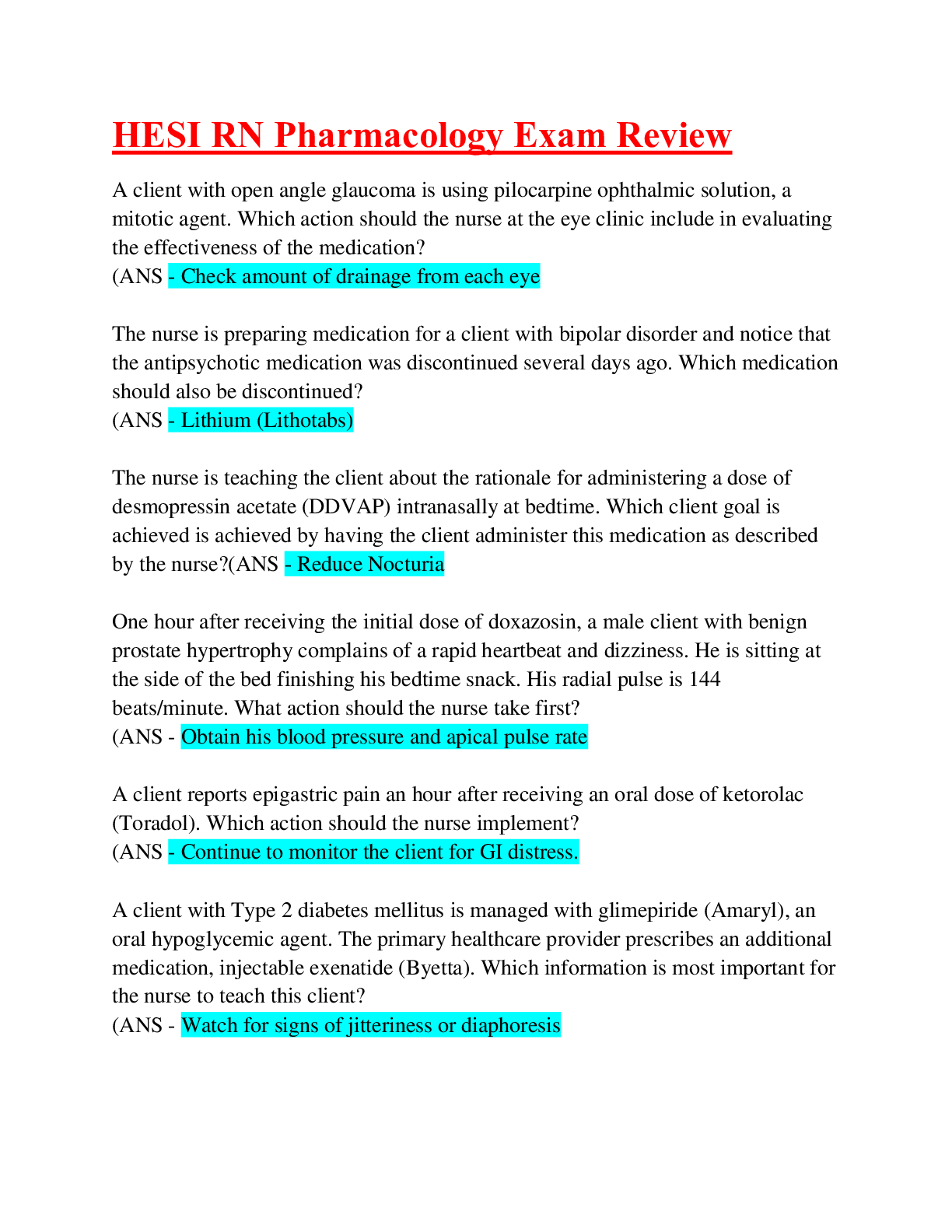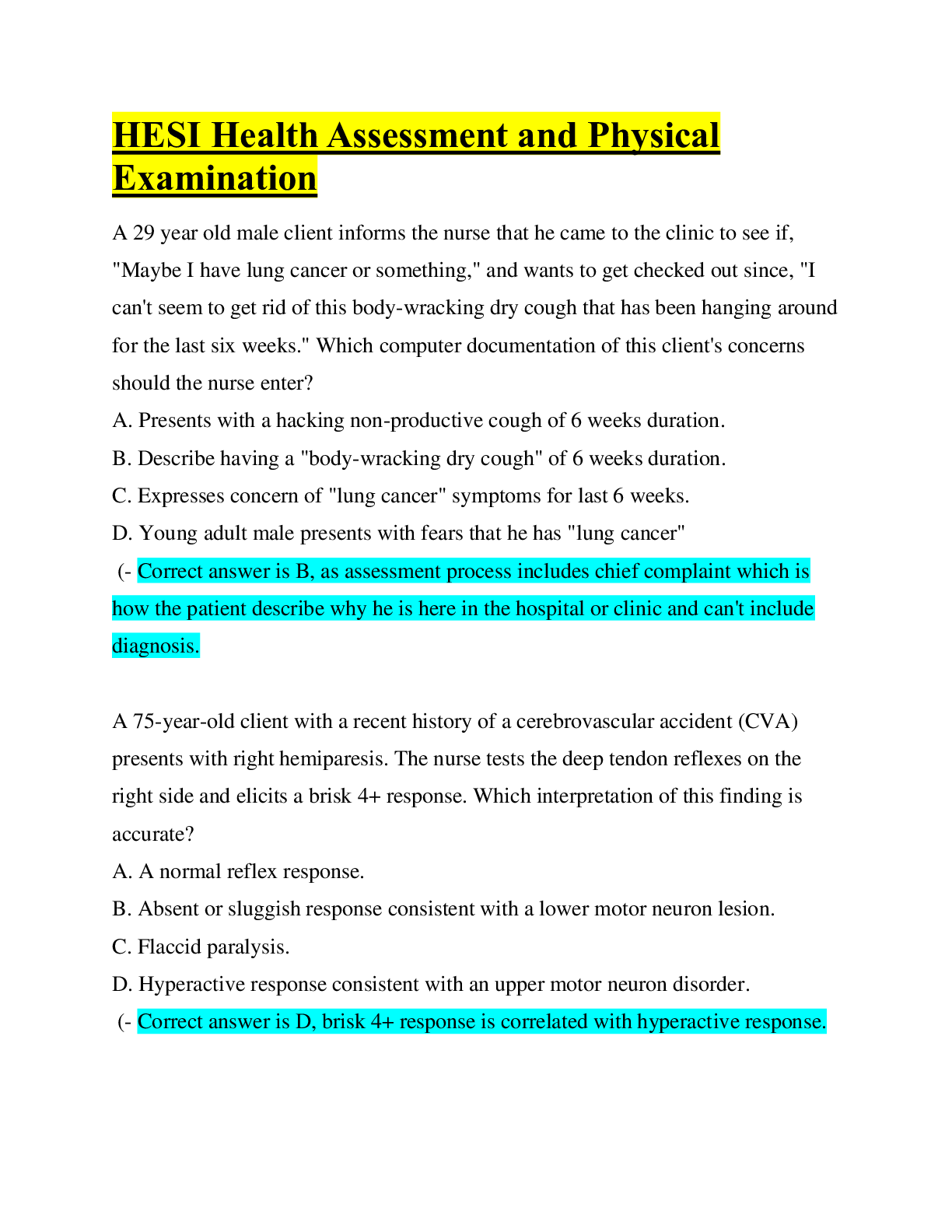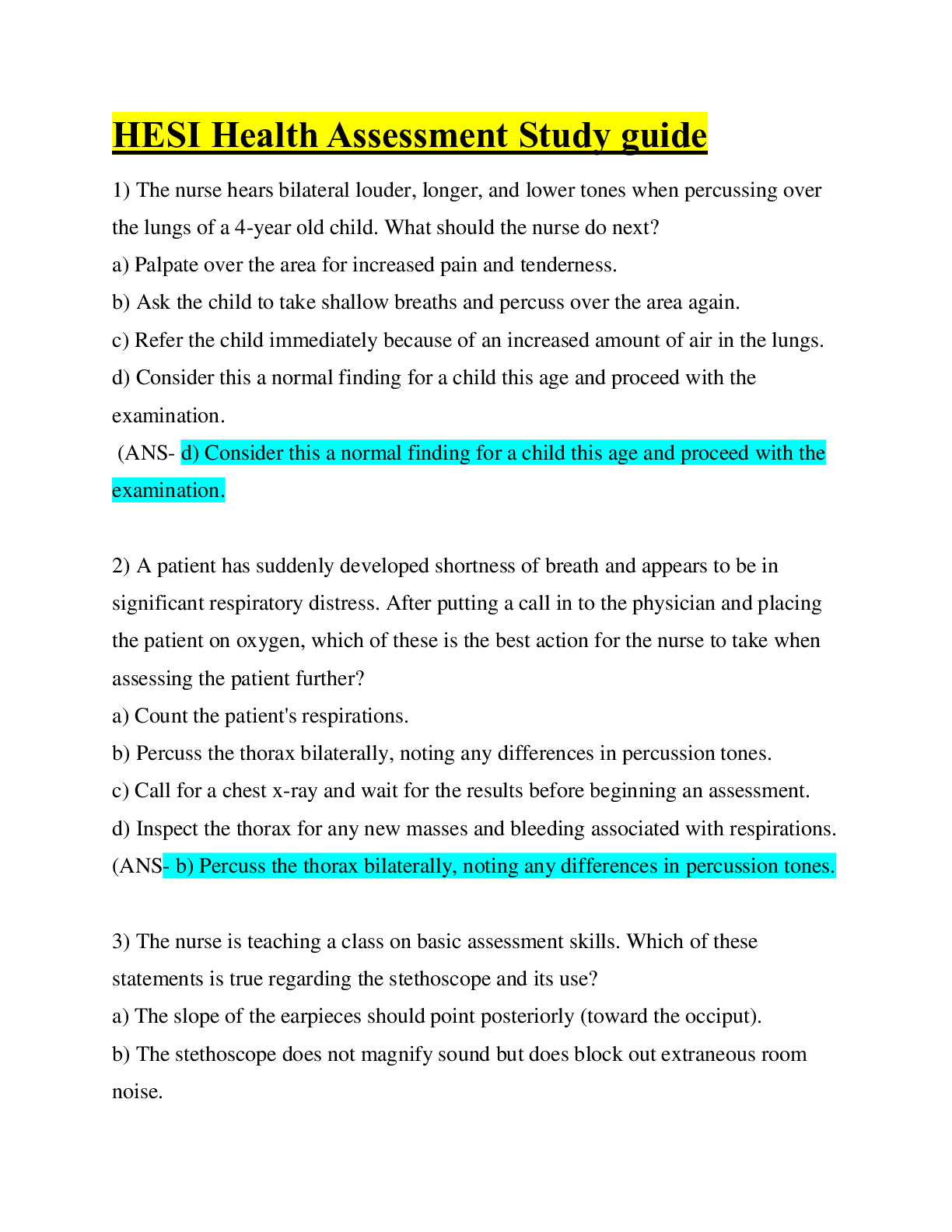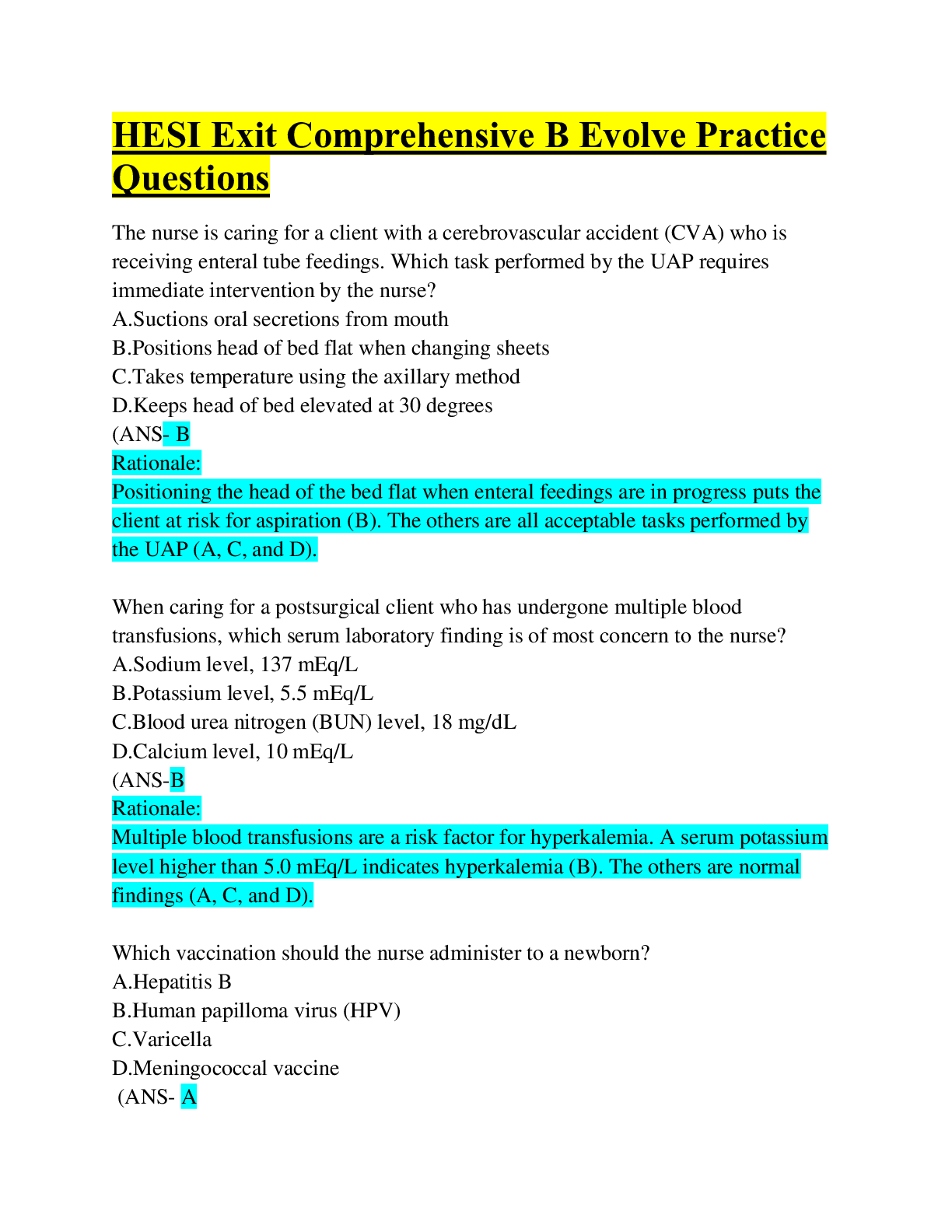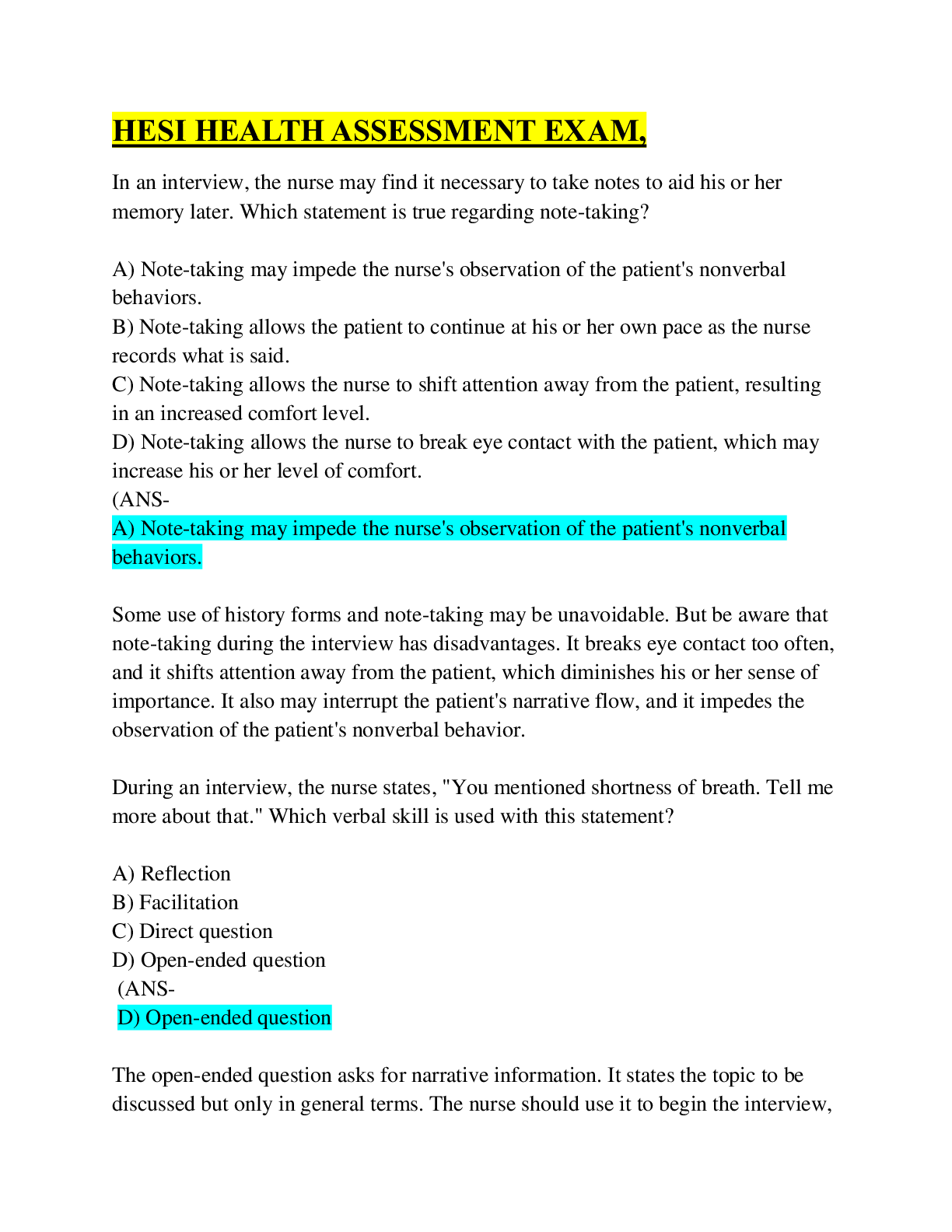Health Care > HESI > HESI Comprehensive Exit Exam/ Latest Complete Solution/ Questions & Answers/Spring (All)
HESI Comprehensive Exit Exam/ Latest Complete Solution/ Questions & Answers/Spring
Document Content and Description Below
Enalapril maleate is prescribed for a hospitalized client. Which assessment does the nurse perform as a priority before administering the medication? Checking the client's blood pressure Checking... the client's peripheral pulses Checking the most recent potassium level Checking the client's intake-and-output record for the last 24 hours (ANS- Checking the client's blood pressure Rationale: Enalapril maleate is an angiotensin-converting enzyme (ACE) inhibitor used to treat hypertension. One common side effect is postural hypotension. Therefore the nurse would check the client's blood pressure immediately before administering each dose. Checking the client's peripheral pulses, the results of the most recent potassium level, and the intake and output for the previous 24 hours are not specifically associated with this mediation. A client is scheduled to undergo an upper gastrointestinal (GI) series, and the nurse provides instructions to the client about the test. Which statement by the client indicates a need for further instruction? "The test will take about 30 minutes." "I need to fast for 8 hours before the test." "I need to drink citrate of magnesia the night before the test and give myself a Fleet enema on the morning of the test." "I need to take a laxative after the test is completed, because the liquid that I'll have to drink for the test can be constipating." (ANS- "I need to drink citrate of magnesia the night before the test and give myself a Fleet enema on the morning of the test." Rationale: No special preparation is necessary before a GI series, except that NPO (nothing by mouth) status must be maintained for 8 hours before the test. An upper GI series involves visualization of the esophagus, duodenum, and upper jejunum by means of the use of a contrast medium. It involves swallowing a contrast medium (usually barium), which is administered in a flavored milkshake. Films are taken at intervals during the test, which takes about 30 minutes. After an upper GI series, the client is prescribed a laxative to hasten elimination of the barium. Barium that remains in the colon may become hard and difficult to expel, leading to fecal impaction. A nurse on the evening shift checks a primary health care provider's prescriptions and notes that the dose of a prescribed medication is higher than the normal dose. The nurse calls the primary health care provider's answering service and is told that the primary health care provider is off for the night and will be available in the morning. What should the nurse do next? Call the nursing supervisor Ask the answering service to contact the on-call primary health care provider Withhold the medication until the primary health care provider can be reached in the morning Administer the medication but consult the primary health care provider when he becomes available (ANS- Ask the answering service to contact the on-call primary health care provider Rationale: The nurse has a duty to protect the client from harm. A nurse who believes that a primary health care provider's prescription may be in error is responsible for clarifying the prescription before carrying it out. Therefore the nurse would not administer the medication; instead, the nurse would withhold the medication until the dose can be clarified. The nurse would not wait until the next morning to obtain clarification. It is premature to call the nursing supervisor. An emergency department (ED) nurse is monitoring a client with suspected acute myocardial infarction (MI) who is awaiting transfer to the coronary intensive care unit. The nurse notes the sudden onset of premature ventricular contractions (PVCs) on the monitor, checks the client's carotid pulse, and determines that the PVCs are not perfusing. What is the nurse's most appropriate action? Document the findings Ask the ED primary health care provider to check the client Continue to monitor the client's cardiac status Inform the client that PVCs are expected after an MI (ANS- Ask the ED primary health care provider to check the client Rationale: The most appropriate action by the nurse would be to ask the ED health care provider to check the client. PVCs are a result of increased irritability of ventricular cells. Peripheral pulses may be absent or diminished with the PVCs themselves because the decreased stroke volume of the premature beats may in turn decrease peripheral perfusion. Because other rhythms also cause widened QRS complexes, it is essential that the nurse determine whether the premature beats are resulting in perfusion of the extremities. This is done by palpating the carotid, brachial, or femoral artery while observing the monitor for widened complexes or by auscultating for apical heart sounds. In the situation of acute MI, PVCs may be considered warning dysrhythmias, possibly heralding the onset of ventricular tachycardia or ventricular fibrillation. Therefore, the nurse would not tell the client that the PVCs are expected. Although the nurse will continue to monitor the client and document the findings, these are not the most appropriate actions of those provided. NPO status is imposed 8 hours before the procedure on a client scheduled to undergo electroconvulsive therapy (ECT) at 1 p.m. On the morning of the procedure, the nurse checks the client's record and notes that the client routinely takes an oral antihypertensive medication each morning. What action should the nurse take? Administer the antihypertensive with a small sip of water Withhold the antihypertensive and administer it at bedtime Administer the medication by way of the intravenous (IV) route Hold the antihypertensive and resume its administration on the day after the ECT (ANS- Administer the antihypertensive with a small sip of water Rationale: The nurse should administer the antihypertensive with a small sip of water. General anesthesia is required for ECT, so NPO status is imposed for 6 to 8 hours before treatment to help prevent aspiration. Exceptions include clients who routinely receive cardiac medications, antihypertensive agents, or histamine (H2) blockers, which should be administered several hours before treatment with a small sip of water. Withholding the antihypertensive and administering it at bedtime and withholding the antihypertensive and resuming administration on the day after the ECT are incorrect actions, because antihypertensives must be administered on time; otherwise, the risk for rebound hypertension exists. The nurse would not administer a medication by way of a route that has not been prescribed. A client who recently underwent coronary artery bypass graft surgery comes to the primary health care provider's office for a follow-up visit. On assessment, the client tells the nurse that he is feeling depressed. Which response by the nurse is therapeutic? "Tell me more about what you're feeling." "That's a normal response after this type of surgery." "It will take time, but I promise you, you will get over this depression." "Every client who has this surgery feels the same way for about a month." (ANS- "Tell me more about what you're feeling." Rationale: The therapeutic response by the nurse is, "Tell me more about what you're feeling." When a client expresses feelings of depression, it is extremely important for the nurse to further explore these feelings with the client. In stating, "This is a normal response after this type of surgery" the nurse provides false reassurance and avoids addressing the client's feelings. "It will take time, but I promise you, you will get over the depression" is also a false reassurance, and it does not encourage the expression of feelings. "Every client who has this surgery feels the same way for about a month" is a generalization that avoids the client's feelings. A client in labor experiences spontaneous rupture of the membranes. The nurse immediately counts the fetal heart rate (FHR) for 1 full minute and then checks the amniotic fluid. The nurse notes that the fluid is yellow and has a strong odor. Which action should be the nurse's priority? Contact the primary health care provider Document the findings Check the fluid for protein Continue to monitor the client and the FHR (ANS- Contact the primary health care provider Rationale: The priority action is for the nurse to contact the primary health care provider. The FHR is assessed for at least 1 minute when the membranes rupture. The nurse also checks the quantity, color, and odor of the amniotic fluid. The fluid should be clear (often with bits of vernix) and have a mild odor. Fluid with a foul or strong odor, cloudy appearance, or yellow coloration suggests chorioamnionitis and warrants notifying the primary health care provider. A large amount of vernix in the fluid suggests that the fetus is preterm. Greenish, meconium-stained fluid may be seen in cases of postterm gestation or placental insufficiency. Checking the fluid for protein is not associated with the data in the question. The nurse would continue to monitor the client and the FHR and would document the findings. A nurse has assisted a primary health care provider in inserting a central venous access device into a client with a diagnosis of severe malnutrition who will be receiving parenteral nutrition (PN). After insertion of the catheter what does the nurse immediately do? Call the radiography department to obtain a chest x-ray Check the client's blood glucose level to serve as a baseline measurement Hang the prescribed bag of PN and start the infusion at the prescribed rate Infuse normal saline solution through the catheter at a rate of 100 mL/hr to maintain patency (ANS- Call the radiography department to obtain a chest x-ray Rationale: The nurse should immediately make arrangements to have a chest x-ray done. One major complication associated with central venous catheter placement is pneumothorax, which may result from accidental puncture of the lung. After the catheter has been placed but before it is used for infusions, its placement must be checked with an x-ray. Hanging the prescribed bag of PN and starting the infusion at the prescribed rate and infusing normal saline solution through the catheter at a rate of 100 mL/hr to maintain patency are all incorrect because they could result in the infusion of solution into a lung if a pneumothorax is present. Although the nurse may obtain a blood glucose measurement to serve as a baseline, this action is not the priority. A rape victim being treated in the emergency department says to the nurse, "I'm really worried that I've got HIV now." What is the most appropriate response by the nurse? "HIV is rarely an issue in rape victims." "Every rape victim is concerned about HIV." "You're more likely to get pregnant than to contract HIV." "Let's talk about the information that you need to determine your risk of contracting HIV." (ANS- "Let's talk about the information that you need to determine your risk of contracting HIV." Rationale: The most appropriate response by the nurse is the one that encourages the client to talk about her condition. HIV is a concern of rape victims. Such concern should always be addressed, and the victim should be given the information needed to evaluate his or her risk. Pregnancy may occur as a result of rape, and pregnancy prophylaxis can be offered in the emergency department or during follow-up, once the results of a pregnancy test have been obtained. However, stating, "You're more likely to get pregnant than to contract HIV" avoids the client's concern. Similarly, "HIV is rarely an issue in rape victims" and "Every rape victim is concerned about HIV" are generalized responses that avoid the client's concern. A client is taking prescribed ibuprofen 200 mg orally four times daily, to relieve joint pain resulting from rheumatoid arthritis. The client tells the nurse that the medication is causing nausea and indigestion. What should the nurse tell the client? "I will contact your primary health care provider." "Stop taking the medication." "Take the medication with food." "Take the medication twice a day instead of four times a day." (ANS- "Take the medication with food." Rationale: Ibuprofen is a nonsteroidal antiinflammatory medication. Side effects include nausea (with or without vomiting) and dyspepsia (heartburn, indigestion, or epigastric pain). If gastrointestinal distress occurs, the client should be instructed to take the medication with milk or food. The nurse would not instruct the client to stop the medication or instruct the client to adjust the dosage of a prescribed medication; these actions are not within the legal scope of the role of the nurse. Contacting the primary health care provider is premature, because the client's complaints are side effects that occasionally occur and can be relieved by taking the medication with milk or food. [Show More]
Last updated: 2 years ago
Preview 1 out of 145 pages
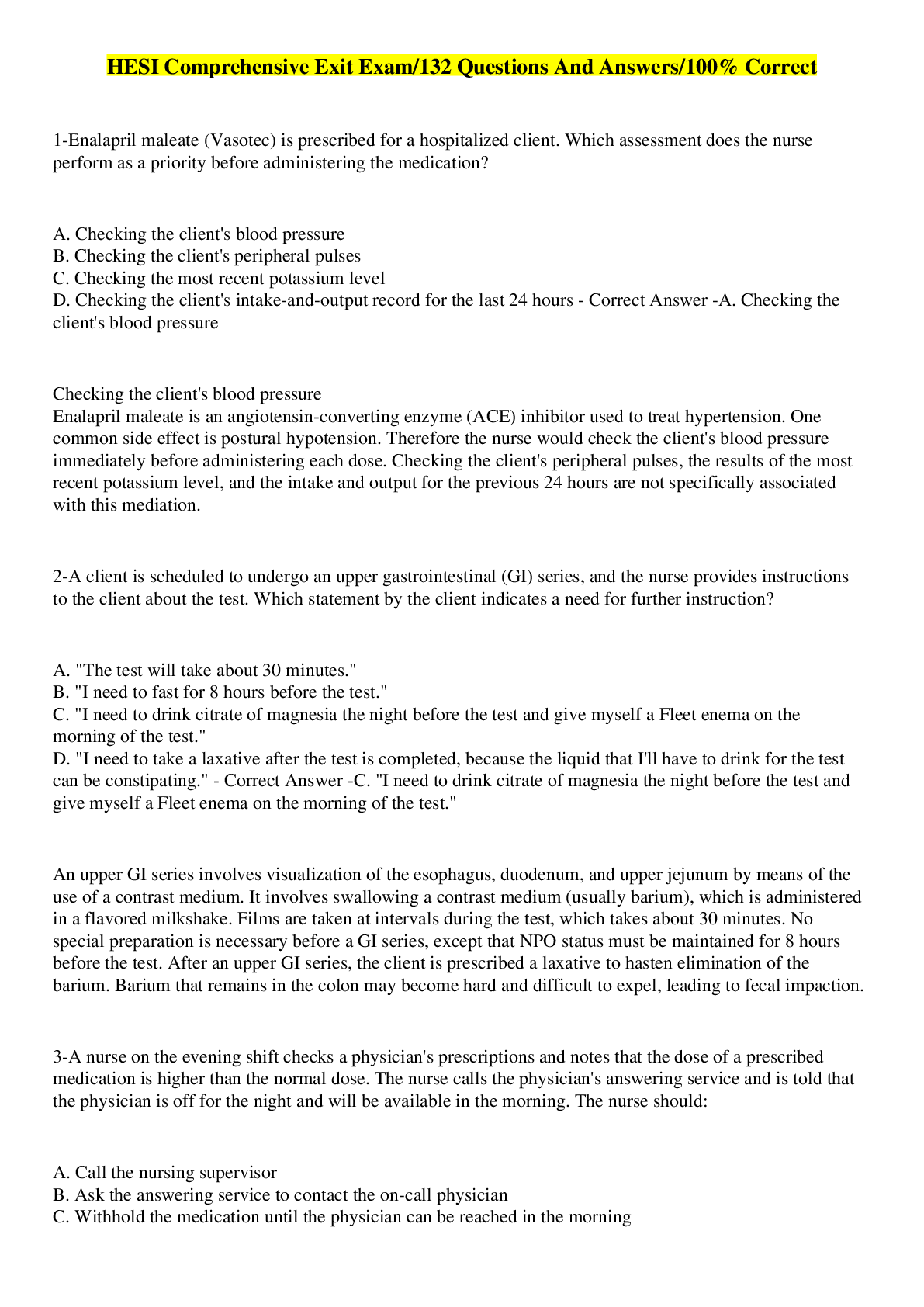
Buy this document to get the full access instantly
Instant Download Access after purchase
Buy NowInstant download
We Accept:

Reviews( 0 )
$13.50
Can't find what you want? Try our AI powered Search
Document information
Connected school, study & course
About the document
Uploaded On
May 16, 2022
Number of pages
145
Written in
Additional information
This document has been written for:
Uploaded
May 16, 2022
Downloads
0
Views
68



